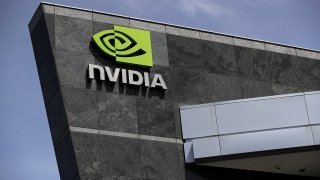
The recent AI boom briefly launched Nvidia into Wall Street's exclusive trillion dollar club.
On Tuesday, the computer chipmaker briefly touched a $1 trillion market capitalization before its stock price pulled back. That means the total value of all its outstanding shares was temporarily above $1 trillion.
When it crossed that threshold, Nvidia momentarily became the fifth publicly traded U.S. company to surpass the $1 trillion mark. If it crosses that threshold again and remains there, Nvidia would join a select group of companies that includes Apple, Microsoft, Alphabet (Google's parent company) and Amazon.
Nvidia has been a leader in computer graphics innovation for nearly a quarter century and currently dominates the market for graphics processing units (GPUs). That technology is used to train and power generative AI tools such as OpenAI's ChatGPT.
Get San Diego local news, weather forecasts, sports and lifestyle stories to your inbox. Sign up for NBC San Diego newsletters.
The viral AI chatbot debuted at the beginning of the year and amassed over 100 million monthly active users within two months.
What Nvidia's rise means for investors
On May 25, Nvidia reported first-quarter earnings for its fiscal 2024, which were better than expected. The company reported revenue of $7.19 billion for the quarter, beating the $6.52 billion analysts predicted, according to Refinitiv consensus estimates.
Money Report
Nvidia reported adjusted earnings per share of $1.09, which surpassed the $0.92 analysts expected.
On May 31, the stock fell slightly throughout the day and ended the trading session at $378.34 per share.
Nvidia shares have risen a little over 159% since the start of the year as of the close of trading on May 31. Here's how much money you would have as of May 31 if you invested $1,000 into Nvidia one, five and 10 years ago.

If you had invested $1,000 into Nvidia one year ago, your investment would be worth about $2,028 as of May 31, according to CNBC's calculations.
Over the past five years, it would have grown to $6,056, and over the past 10 years to $111,978.
Research before you invest
Although it may be tempting to invest in whichever company is the most popular at the moment, it's important to do your research. For starters, review the company's annual and quarterly reports in order to gain an understanding of how the firm has performed over the past few years.
Remember, a stock's recent performance is no guarantee of how well it may perform over the long term. The stock market can be fickle, and there isn't a surefire way to predict how it may behave in the future.
For most investors, a passive investment strategy tends to be a good alternative to hand-picking individual stocks. Passive funds, such as index mutual funds or exchange-traded funds, allow you to invest in a vast array of companies, helping to diversify your portfolio and mitigate the risk of a decline in any one stock you own dragging down your overall returns.
And since a manager isn't actively running the fund, passive funds tend to be less expensive.
Many experts recommend investing in low-cost funds that mirror market indexes, such as the S&P 500, which tracks the performance of roughly 500 large-company U.S. stocks.
As of May 31, the S&P 500 rose by about 1% over the past 12 months, according to CNBC's calculations. The market index's value has increased by about 54% since 2018 and grown by about 156% since 2013, according to CNBC.
DON'T MISS: Want to be smarter and more successful with your money, work & life? Sign up for our new newsletter!
Get CNBC's free report, 11 Ways to Tell if We're in a Recession, where Kelly Evans reviews the top indicators that a recession is coming or has already begun.






